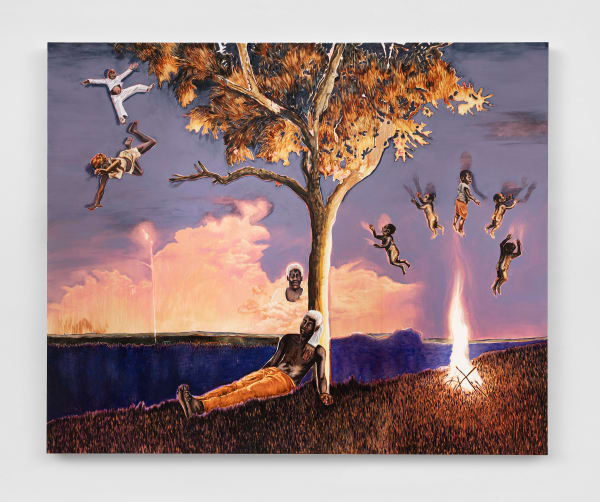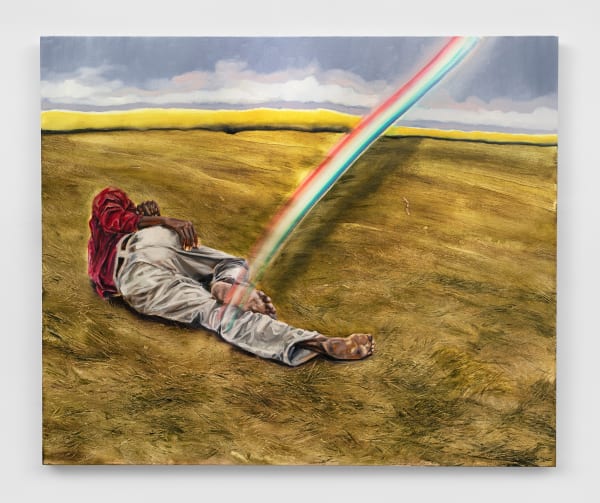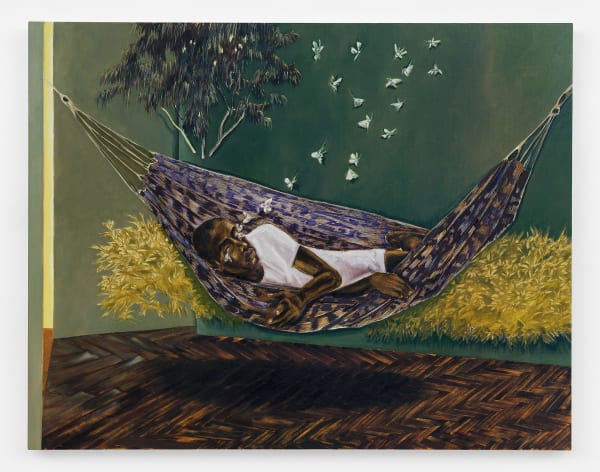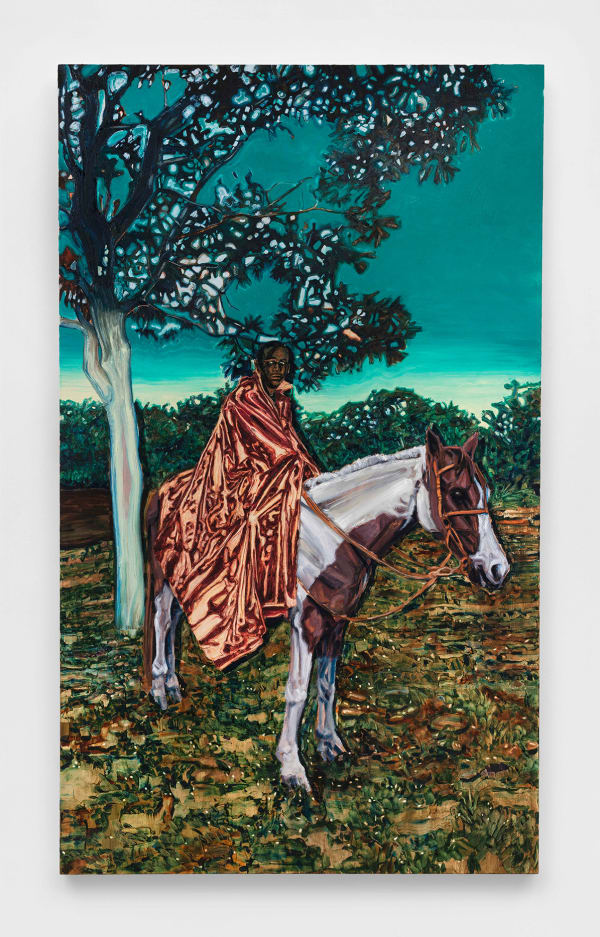Outras águas / Other waters Antonio Obá
You go, you stay, you never come back!
—João Guimarães Rosa, “The Third Bank of the River” (1962)
Mendes Wood DM New York is pleased to announce Outras águas / Other waters, Antonio Obá’s second solo exhibition in New York. Comprising new paintings and bronze sculptures, Outras águas / Other waters intertwines a panorama of references across the histories of Brazilian literature, music, and painting, exploring shared histories and personal resonances that at once engage and reconstruct the worlds embedded within.
The point of departure for Outras águas / Other waters is the seminal writing of the Brazilian author and diplomat João Guimarães Rosa, in particular his short story “The Third Bank of the River” (1962). The story tells of a man who secludes himself from his family, his friends, and society to live in a canoe, sailing up and down a river in solitude. Guimarães Rosa explores this notion of solitude as a return to the self, defending the principle that the real encounter between a person and themselves happens within silence, in observation of nature, and in search for the unknown. This search is the premise of Obá’s exhibition.
The works make references across time and place, from the Brazilian Baroque through late twentieth-century Black American painting, to recent Brazilian popular music. These references, however, are freed from their roots and rendered universal to any observer—rather it is from the point of the universal unknown that Outras águas / Other waters draws upon. Throughout the exhibition Obá revisits places and stories from his childhood, while also representing unknown figures and figments. His approach is both biographical and oneiric—dream and painting replace reality; memory acts as the central axis through which he re-designs his past.
Several works in the exhibition reference the Sankofa, a West African Akan symbol of a bird with its head turned backward and its feet facing forward. It symbolizes the act of looking back in order to acquire the knowledge to look forward, emphasizing the importance of one’s cultural heritage. In Sankofa: cavaleiro (Sankofa: horseman), 2022, a man sits atop his horse facing backward in a landscape dotted by fireflies flickering at dusk. Such symbols in Obá’s work are a way of seeking, through nature, the source of existential feelings and thoughts. Like Guimarães Rosa, Obá looks at his familiar environment in order to subvert it, attempting to universalize these subversions through natural imagery.
In Encantaria - Gorgone Macarea, 2022, a man lays in a hammock with moths streaming from his eyes. The background is a deep green, surrounded by a landscape that suggests the Brazilian hinterland as described by Guimarães Rosa—a non-place, a place both deserted and mysteriously full of possibilities. The moths are a Brazilian species found in the Amazon named Gorgone macarea, known for feeding on the tears of birds. In nature, Obá’s surrealism finds a fertile ground to represent human feelings. While crying, the man rests by an abyss, which could be his own shadow or an unknown trench. Obá’s compositions suggest an impossible pictorial scenario, their perspectives subverting the natural order of things.
Antonio Obá rewrites his own narrative; like the nameless character in Guimarães Rosa’s short story, Obá also questions the truth of his reality. In his own words, his works reflect “the idea of compositions that emblematically play with this situation—what appears to be, what is apparently there but sometimes is not, that which is sometimes bifurcated, throwing you into a visual trap that subverts the plot of things.” Obá’s world is a delicate construct of improbable shadows, illusion, and secret symbols that look toward the past to build a hopeful future—a new river, a landscape that lies beyond the unconscious and in the realm of dreams.
-
![Antonio Obá, Variação sobre Sankofa – Quem toma as rédeas abre caminhos [Variation on Sankofa – Whosoever Takes the Reins Opens Paths], 2021](data:image/gif;base64,R0lGODlhAQABAIAAAAAAAP///yH5BAEAAAAALAAAAAABAAEAAAIBRAA7) Antonio Obá, Variação sobre Sankofa – Quem toma as rédeas abre caminhos [Variation on Sankofa – Whosoever Takes the Reins Opens Paths], 2021
Antonio Obá, Variação sobre Sankofa – Quem toma as rédeas abre caminhos [Variation on Sankofa – Whosoever Takes the Reins Opens Paths], 2021 -
 Antonio Obá, Angelus, 2022
Antonio Obá, Angelus, 2022 -
 Antonio Obá, Orev - pouso (Orev - landing), 2022
Antonio Obá, Orev - pouso (Orev - landing), 2022 -
![Antonio Obá, Sankofa: cavaleiro [Sankofa: Horseman], 2022](data:image/gif;base64,R0lGODlhAQABAIAAAAAAAP///yH5BAEAAAAALAAAAAABAAEAAAIBRAA7) Antonio Obá, Sankofa: cavaleiro [Sankofa: Horseman], 2022
Antonio Obá, Sankofa: cavaleiro [Sankofa: Horseman], 2022 -
 Antonio Obá, Fata Morgana nº 1, 2022
Antonio Obá, Fata Morgana nº 1, 2022 -
 Antonio Obá, Encantaria - Gorgone Macarea, 2022
Antonio Obá, Encantaria - Gorgone Macarea, 2022 -
 Antonio Obá, Angelus, 2022
Antonio Obá, Angelus, 2022 -
![Antonio Obá, Obra em negro [Work in Black], 2022](data:image/gif;base64,R0lGODlhAQABAIAAAAAAAP///yH5BAEAAAAALAAAAAABAAEAAAIBRAA7) Antonio Obá, Obra em negro [Work in Black], 2022
Antonio Obá, Obra em negro [Work in Black], 2022 -
 Antonio Obá, Káwó - personagem guardião (Káwó - guardian character), 2022
Antonio Obá, Káwó - personagem guardião (Káwó - guardian character), 2022 -
 Antonio Obá, Contenda - dois títeres (Strife - two pawns), 2022
Antonio Obá, Contenda - dois títeres (Strife - two pawns), 2022 -
 Antonio Obá, um amálgama. Cavaleiro monge - ascendência (an amalgam. Horseman monk - ancestry), 2022
Antonio Obá, um amálgama. Cavaleiro monge - ascendência (an amalgam. Horseman monk - ancestry), 2022

![Antonio Obá, Variação sobre Sankofa – Quem toma as rédeas abre caminhos [Variation on Sankofa – Whosoever Takes the Reins Opens Paths], 2021](https://artlogic-res.cloudinary.com/w_600,c_limit,f_auto,fl_lossy,q_auto,dpr_auto/artlogicstorage/mendeswooddm/images/view/9d7939498916e43ff8db02e03d52d827j/mendeswooddm-antonio-ob-varia-o-sobre-sankofa-quem-toma-as-r-deas-abre-caminhos-variation-on-sankofa-whosoever-takes-the-reins-opens-paths-2021.jpg)


![Antonio Obá, Sankofa: cavaleiro [Sankofa: Horseman], 2022](https://artlogic-res.cloudinary.com/w_600,c_limit,f_auto,fl_lossy,q_auto,dpr_auto/artlogicstorage/mendeswooddm/images/view/54d55a4e79688a2564a6cec938403fd8j/mendeswooddm-antonio-ob-sankofa-cavaleiro-sankofa-horseman-2022.jpg)



![Antonio Obá, Obra em negro [Work in Black], 2022](https://artlogic-res.cloudinary.com/w_600,c_limit,f_auto,fl_lossy,q_auto,dpr_auto/artlogicstorage/mendeswooddm/images/view/beca9a6fef853924437d1b3bdbc595e4j/mendeswooddm-antonio-ob-obra-em-negro-work-in-black-2022.jpg)




